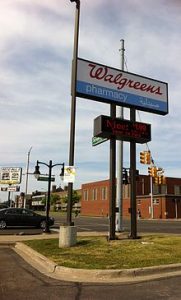 When we visited Dearborn, MI I was surprised at how many Middle-Eastern restaurants and Arabic signs there were. I learned that Dearborn has many nicknames that include “Little Yemen or Dearbonistan” and this prompted me to do this blog post on the history of the group in Dearborn. My first impression was that this migration was a recent one, however upon researching this topic I learned that there was a great influx of people from the Middle East in the early part of the 20th century. The migration also ties in to what we are talking about in class since these migrants came in to work for the factories in the auto industry during that time period. Most of these migrants were of Lebanese and Assyrian descent and were actually Christians or Chaldean, not Muslim. Some from these groups fled Christian persecution that was occurring in the Middle East at the time. These immigrants were employed at Ford’s River Rouge factory (which we were able to tour) around the time of its conception and have had a huge impact on the region ever since. Today, it is estimated that there are approximately 200,000 people of Middle-Eastern descent living in the four counties in southeastern Michigan (including Wayne county, which contains Detroit and Dearborn). There has been a recent migration of people from Iraq and Yemen, who fled their homelands during the Gulf and Iraqi wars and came to southeastern Michigan in search of economic opportunity. The story of the Middle Eastern population contradicts that of the population movement seen in the city of Detroit; the Middle-Eastern population has been growing (“From 1990 to 2000 the percentage of people speaking Arabic in the home increased by 90% in the Wayne, Oakland, and Macomb counties region, with a 106% increase in Wayne County, a 99.5% increase in Macomb County, and a 41% increase in Oakland County”) whereas Detroit went from a population of 1.8 million to today’s 600,000!
When we visited Dearborn, MI I was surprised at how many Middle-Eastern restaurants and Arabic signs there were. I learned that Dearborn has many nicknames that include “Little Yemen or Dearbonistan” and this prompted me to do this blog post on the history of the group in Dearborn. My first impression was that this migration was a recent one, however upon researching this topic I learned that there was a great influx of people from the Middle East in the early part of the 20th century. The migration also ties in to what we are talking about in class since these migrants came in to work for the factories in the auto industry during that time period. Most of these migrants were of Lebanese and Assyrian descent and were actually Christians or Chaldean, not Muslim. Some from these groups fled Christian persecution that was occurring in the Middle East at the time. These immigrants were employed at Ford’s River Rouge factory (which we were able to tour) around the time of its conception and have had a huge impact on the region ever since. Today, it is estimated that there are approximately 200,000 people of Middle-Eastern descent living in the four counties in southeastern Michigan (including Wayne county, which contains Detroit and Dearborn). There has been a recent migration of people from Iraq and Yemen, who fled their homelands during the Gulf and Iraqi wars and came to southeastern Michigan in search of economic opportunity. The story of the Middle Eastern population contradicts that of the population movement seen in the city of Detroit; the Middle-Eastern population has been growing (“From 1990 to 2000 the percentage of people speaking Arabic in the home increased by 90% in the Wayne, Oakland, and Macomb counties region, with a 106% increase in Wayne County, a 99.5% increase in Macomb County, and a 41% increase in Oakland County”) whereas Detroit went from a population of 1.8 million to today’s 600,000!
Research from Wayne State University suggests that the Arab-American community received $7.7 in salaries and earnings [huh?? – the prof], which doubles Detroit’s annual budget. This story of resilience and growth has provided a silver lining to the decline seen in Detroit and offers hope that there is a bright future for this particular area.
Sources:
http://content.time.com/time/magazine/article/0,9171,2028057,00.html
https://en.wikipedia.org/wiki/History_of_the_Middle_Eastern_people_in_Metro_Detroit
http://www.businessinsider.com/what-life-is-like-for-arab-refugees-living-in-detroit-2015-3
If you’re going to put in a picture, at least use one where it’s easier to see the Arabic!
My hunch is that the Dearborn population is comprised of more recent immigrants and has a larger percentage who are Muslim. By now older generations of immigrants will have scattered around the area. In principle you can probably generate a map from Census data. How, I don’t know!
This article deals mostly with the Arab population of Dearborn but I am wondering if Detroit has had a similar increase in Arab population in the past several decades. If so this influx of immigrants could help the city of Detroit by increasing the tax base in the city as well as by providing more consumers to patronize Detroit businesses.
Michael, I think immigrants are less inclined to move to the city because of the high tax rate, hence why they move to Dearborn. Like Mr. LaVelle at the Fed mentioned, the high tax detracts people and businesses from moving their operations.
Also, I researched that much of the influx of Arabs within the region at the turn of the 19th century was due to the fact that Henry Ford was a staunch Anti-Semetic, and therefore, wished to employ other minorities. Its impact on the region can still be seen today, but the funny the about Dearborn now is that its become an area that celebrates all races. Just my little take on the whole population discussion.